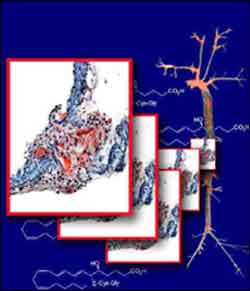Penn scientists identify novel pathway in aneurysms

Cross-section of an aneurysm superimposted over aorta and branching vessels from an atherosclerotic mouse. Lipids in aneurysm and atherosclerotic lesions appear in red. Credit: Lei Zhao, Tim Cyrus, Rolf Grabner/Nature Medicine 10(9): 966-73
Possible implications for some anti-inflammatory drugs used in fighting cardiovascular disease
Very little is known about how aortic aneurysms initially form and progress. Now, researchers from the University of Pennsylvania School of Medicine have shown in an atherosclerotic animal model that susceptibility for developing aneurysms increases significantly when an inflammation pathway important in asthma is activated. Mice without the inflammation gene were protected from aneurysms.
Colin D. Funk, PhD, former Professor of Pharmacology and Medicine, and Lei Zhao, MD, PhD, Research Associate, both in Penn’s Center for Experimental Therapeutics, report their findings in this week’s online publication and the September issue of Nature Medicine. Funk is now the Canada Research Chair in Molecular, Cellular and Physiological Medicine, Queen’s University, Kingston, Canada.
“This is the first time anyone has ever shown aneurysm formation associated with this inflammation pathway,” says Funk. Drugs that block the formation and action of this pathway are currently used to treat inflammation in the airways of asthmatics. “Perhaps they may become useful to treat patients who are susceptible to developing aortic aneurysms by blocking their progression and eventual rupture,” he adds.
A gene for the 5-lipoxygenase-activating protein, which is required to synthesize leukotrienes, potent inflammatory molecules, has been associated with heart-disease risk. Leukotrienes, which constrict airways in asthmatics and contribute to inflammation in the lungs, are also associated with cardiovascular disease. They are secreted by inflammatory cells that gather at injured blood vessels.
Abdominal aortic aneurysms are a bulging region – up to twice the normal diameter – in the largest artery of the body. There is no known cure, with the only option of “watchful waiting” until surgical repair is attempted, says Funk. Often, but not always, these types of aneurysms are associated with arteriosclerosis, a chronic inflammatory disease of the blood-vessel wall, consisting of fatty deposits that progress into major plaques that eventually break off from the inner lining and lead to heart attacks. “The danger of aneurysms is that we don’t normally carry out routine screening for their detection and by the time they are found most of the progressive damage may have already occurred,” explains Funk.
“This is a surprising finding since at first we weren’t even looking for aneurysms, we were trying to confirm the arteriosclerosis-leukotriene connection,” comments Zhao. The researchers found the 5-lipoxygenase enzyme mainly in macrophages in the outer layer of blood vessels not in the fatty atherosclerotic lesions of the inner layer, as expected. (Macrophages engulf such foreign objects as cellular debris, excess fats, and dying cells.) When the researchers inactivated the gene in a mouse model of arteriosclerosis, the number and degree of severity of aneurysms in the mice was markedly reduced. “In humans it has been very difficult to characterize the mechanisms for aneurysm formation and progression,” says Funk. “Often, studies have only revolved around pathological specimens obtained at autopsy or at the time of surgery.”
They concluded that leukotrienes derived from 5-lipoxygenase are one important clue in the progression of aneurysms but not in early atherosclerosis. More studies will be required in other models of aneurysm formation and in larger animals using currently available 5-lipoxygenase blockers before testing can begin in humans, say the researchers.
Media Contact
More Information:
http://www.uphs.upenn.eduAll latest news from the category: Health and Medicine
This subject area encompasses research and studies in the field of human medicine.
Among the wide-ranging list of topics covered here are anesthesiology, anatomy, surgery, human genetics, hygiene and environmental medicine, internal medicine, neurology, pharmacology, physiology, urology and dental medicine.
Newest articles

Machine learning algorithm reveals long-theorized glass phase in crystal
Scientists have found evidence of an elusive, glassy phase of matter that emerges when a crystal’s perfect internal pattern is disrupted. X-ray technology and machine learning converge to shed light…

Mapping plant functional diversity from space
HKU ecologists revolutionize ecosystem monitoring with novel field-satellite integration. An international team of researchers, led by Professor Jin WU from the School of Biological Sciences at The University of Hong…

Inverters with constant full load capability
…enable an increase in the performance of electric drives. Overheating components significantly limit the performance of drivetrains in electric vehicles. Inverters in particular are subject to a high thermal load,…





















